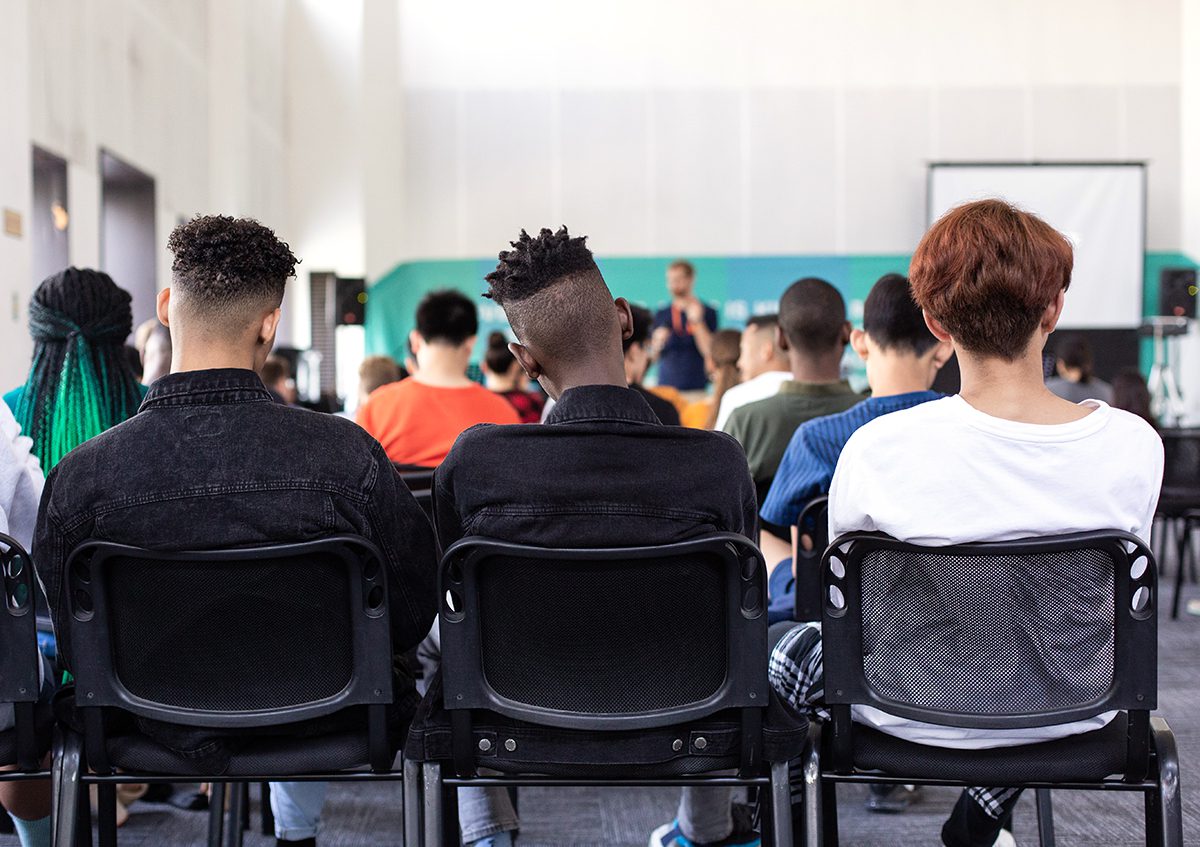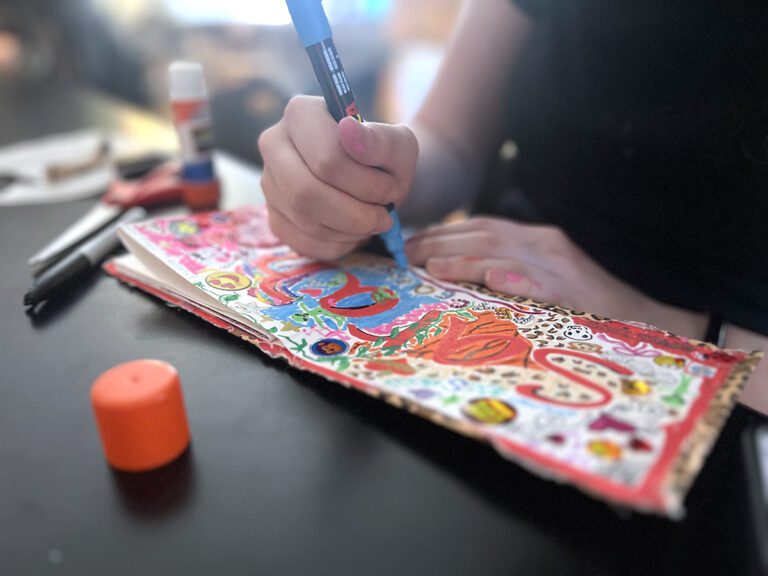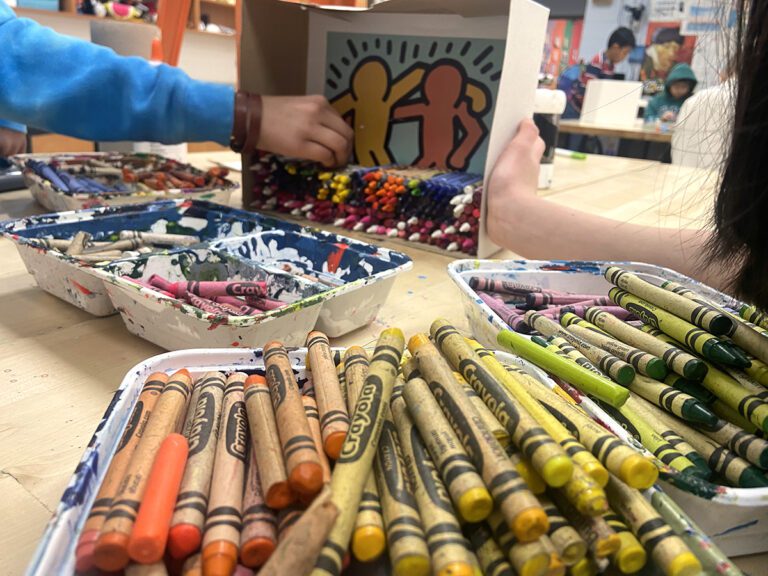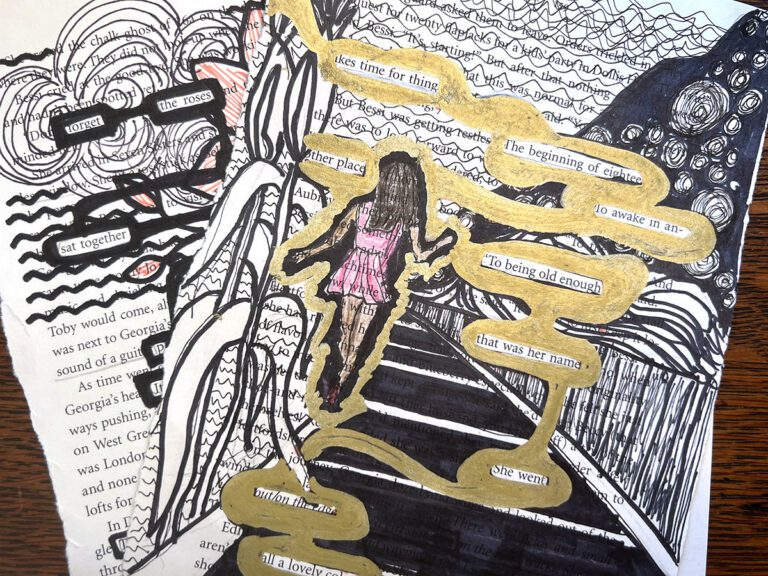We recognize that it may not be permissible to engage in discussions of racial equity or critical race theory at your school. Keep your district regulations, community, and state laws in mind at all times.
Critical race theory (CRT) is a term that’s been flooding the news lately. Whatever your personal thoughts are on CRT, it’s part of the educational climate. As art teachers, we need to stay informed about what’s going on and how it affects our classroom and students.
As of this article’s publication, Arizona, Idaho, Iowa, New Hampshire, Tennessee, Texas, Oklahoma, and South Carolina have passed state laws banning the discussion of racial equity in schools. Twenty-six more states introduced bills to follow suit. These bills assert that discussions of racial equity are divisive and thus not appropriate in a school setting.
The bills are varied in their language. They range from banning the discussion of divisive concepts and conversations on racial equity to limiting which resources teachers may use. According to Law Insider, “divisive concepts” refers to concepts that imply that “the United States is fundamentally racist or sexist.” Some lawmakers have argued that CRT falls under these divisive concepts. However, that is not explicitly listed in the definition.
Meanwhile, fifteen states and the District of Columbia have laws or policies requiring ethnic studies throughout K–12 education. This includes teaching about racial equity.
Let’s start by taking a closer look at where critical race theory came from and what it is.
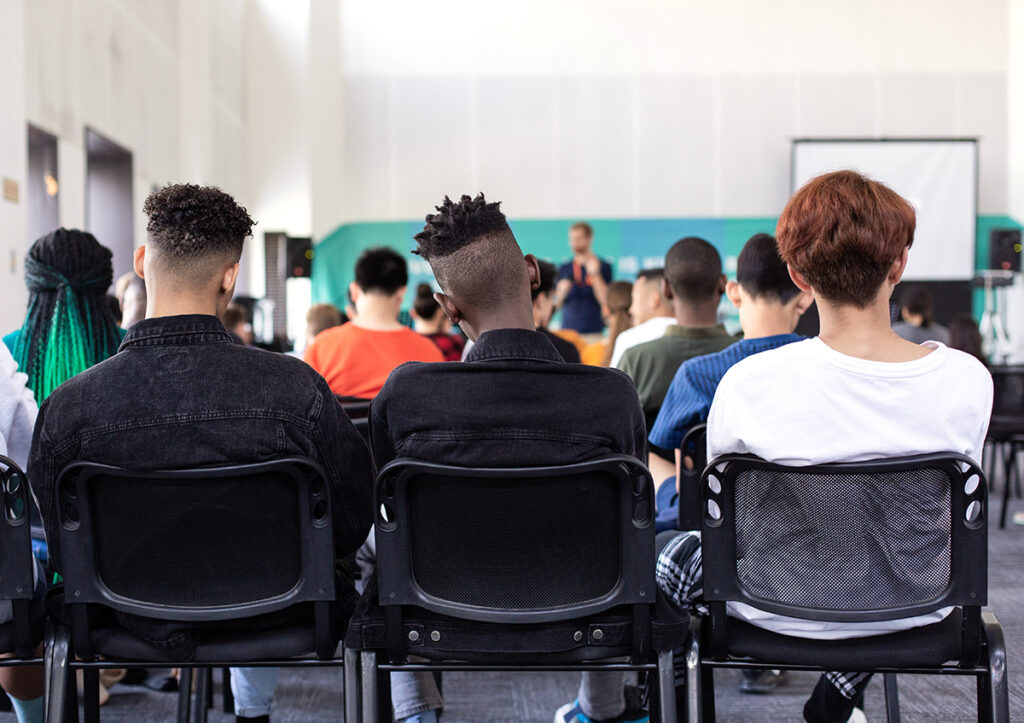
To make sure we’re all on the same page, let’s start with definitions of words and phrases that will come up.
- People of color (POC): This phrase is a collective term that refers to non-White racial groups. You may also see the acronym BIPOC, which stands for Black, Indigenous, and people of color.
- Race: This definition can vary from country to country. In the United States, it refers to a group of people who have similar physical and ancestral characteristics.
- Racism: This is race prejudice with social and institutional power. While all people can be prejudiced, racism involves the power to carry out these prejudices through laws and institutional rules.
- System or institution: This is a social governing body. This can be broad, like the educational system, housing market, or criminal justice system. It can also be more narrow, like your school district or homeowner’s association.
What is critical race theory? What is it not?
Critical race theory is a theoretical lens used to examine race and racism and how they relate to systems of power. It was introduced in 1970 in the writings of civil rights lawyer Derrick Bell. He described how race and racism affected laws and the enforcement of those laws. In the 1980s, scholars began to apply CRT to education at the university level. This was done by asking questions to assess their curriculum, such as, “What type of texts are being taught in school, and who are they written by?” The goal was to ensure that all voices, not only the voices of those in power, are heard in places like the courtroom and classroom.
Since the mid-1980s, CRT has been applied to all levels of education. However, it is typically taught at the university level. Critical race theory analyzes the role race may play in institutions (housing, education, law, healthcare, and more) and how that could impact people and systems today.
While CRT applies to all BIPOC, there are many subgroups that focus on the intricacies unique to specific marginalized communities. Some subgroups include disability critical race studies (DisCrit), Latinx critical race studies (LatCrit), Asian American critical race studies (AsianCrit), and Black critical race studies (BlackCrit).
There are five tenets of CRT in education, as phrased by Rita Kohli in Race Ethnicity and Education:
- The centrality and intersectionality of race and racism
According to CRT, race is a social construct, not biological. It states that racism is a normal part of society and embedded in institutions and systems. The systems allow the continuation of racial inequity, not individual people. The intersectionality of race with other forms of oppression (e.g. gender or class) is indispensable. - The challenge to dominant ideology
CRT states that the dominant ideology in the United States intentionally left out the voices of people of color. - The commitment to social justice
CRT prioritizes equity by removing privilege and providing opportunity across racial lines. - The centrality of experiential knowledge
CRT recognizes the scholarly relevance of people of color’s lived experiences. Because their voices are left out of the dominant ideology, experiential knowledge is often the only source available. - The interdisciplinary perspective
CRT acknowledges that nothing exists in a vacuum. It’s essential to look at things from multiple contexts to get as full of a story as possible.
Critical race theory is not focused on individual actions. Instead, it focuses on dominant systems and how race and racism play a part in those systems. This means that looking at how one person may act or fall into a stereotype is not CRT. However, when someone tells a story of how their race affected an interaction with a system, it’s accepted as experiential knowledge: one of the tenets of CRT. It’s also imperative to note that antiracism and critical race theory are different. Antiracism focuses on personal choices and decisions. Critical race theory is a lens through which we examine the world and systems within it.
There’s a wide variety of viewpoints about CRT. Some are concerned that critical race theory may create “another great divide in America.” As a result, some believe CRT may identify and separate people in a negative manner instead of through a lens of unity or introduce the thought that the United States could be “fundamentally racist” through the analysis of core historical documents.

What is racial equity, and why is it important to discuss race?
Racial equity is both a process and a goal. It refers to what the world could look like if one’s race no longer predicted how they fare. According to Racial Equity Tools, “This includes the elimination of policies, practices, attitudes, and cultural messages that reinforce differential outcomes by race or fail to eliminate them.”
If you can guide conversations on racial equity and race, there are many benefits. Openness to discussing topics of race in your classroom is essential to cultivating student empathy. Avoiding the topic of race can create future resistance to discussing race in any context. This can lead to emotionally charged responses from students rather than thoughtful ones. According to HealthyChildren.org, “. . . as early as six months, a baby’s brain can notice race-based differences. By ages two to four, children can internalize racial bias. By age twelve, many children become set in their beliefs.” Students are already navigating race and racial bias. This happens whether the adults in their lives believe they are ready to or not. Facilitating a space for respectful discussions about race provides an environment where students can grow in their cultural understanding.
Explore these resources on how to build a safe and respectful classroom environment:
- Everything You Need to Know About Classroom Management in the Art Room
- How to Get Students to Open Up in the Classroom
- Building Positive Relationships PRO Pack
- Why Building Relationships Should Be at the Center of Everything You Do
- “Two Reasons Why It’s Not ‘One More Thing’” The Art of SEL Podcast
- How to Help Students Process, Reflect, and Enact Change
If you’re allowed to have discussions on racial equity in your class, it can be highly rewarding. Approaching a lesson with a critical race lens requires that you be patient and self-reflective. It takes time and practice! It’s also important to be patient with your students. Take time to research how to create a safe place for your students to have a conversation about race.
Here are a few helpful resources:
- Learning Policy Institute: A Restorative Approach for Equitable Education
- Learning for Justice: Know how to talk about race
- National Education Association: Creating the Space to Talk About Race in Your School
If you can incorporate racial equity into your art curriculum, here are some grade-specific suggestions to get you started.
The Teaching Tolerance Anti-Bias Framework lays out a set of goals by grade level. We have taken a few of these goals and mapped out corresponding art activities. However, only you know what discussions and lessons are appropriate for your students and school community. Always adhere to your state laws. Additionally, you may feel your students are on a different level, and that’s fine! Each idea includes several variations to select from and hits multiple CRT tenents. Choose one that will allow your students to be the most successful.

A goal for grades K–5 is to know about people who helped stop unfairness and worked to make life better for many.
Picture books are great for all ages. Who doesn’t love storytime? In the art room, read a picture book about someone breaking into a system they were excluded from because of their race. This centralizes experiential knowledge. Study the illustrations. How did the illustrator use the elements and principles to show the differences between people? This question brings in an interdisciplinary perspective. Provide a list of people who have broken into a system that once excluded them. Ask students to create an artwork that illustrates a notable part of one of their stories. Then, have them write a short reflection about their piece and include how they used the elements of art to illustrate their story.
Examples of picture books include:
- Side by Side/Lado a Lado: The Story of Dolores Huerta and Cesar Chavez/La Historia de Dolores Huerta y Cesar Chavez by Joe Cepeda
- The Story of Ruby Bridges by Robert Coles
- No Voice Too Small: Fourteen Young Americans Making History by Lindsay H. Metcalf
- Sometimes People March by Tessa Allen
- When We Were Alone by David A. Robertson and Julie Flett
Not quite finding what you’re looking for? Here’s a list of six picture books that prompt awareness of self and others. This list of 100 children’s books about diversity and inclusion is a great compilation that shows a commitment to social justice.
A goal for grades 3–6 is to know that words, behaviors, rules, and laws that treat people unfairly based on their group identities cause real harm.
Choose three artworks that depict segregation and use it to guide a discussion. Frame those fighting against segregation as challenging the dominant ideology. Take time to examine the artwork collaboratively. Who are the people in the artwork? How is segregation visually depicted using the elements and principles?
Examples of artworks you could use:
- Rosa Parks by Marshall D. Rumbaugh
- Mendez v. Westminster by Rafael López
- The Door (Admissions Office) by David Hammons
- Bar and Grill by Jacob Lawrence
- 415 braids by Nalakwsis
Are you looking for resources on how to approach a difficult topic at a young age? The following titles are all true stories of elementary-age students facing segregation.
- Ruby Bridges Goes to School: My True Story by Ruby Bridges
- Separate is Never Equal: Sylvia Mendez and Her Family’s Fight for Desegregation by Duncan Tonatiuh
- Northbound: A Train Ride Out of Segregation by Michael S. Bandy, Eric Stein, and James E. Ransome
A goal for grades 6–9 is to know all people are connected to others and can relate despite differences.
Prompt students to take a couple of minutes to reflect on who their role model is. Is it someone they know personally? Is it a celebrity? Why is this person their role model? Ask them who society (or the dominant culture) pushes as role models. Centralize experiential knowledge by discussing the reasons why. Introduce artists like Amy Sherald and Kehinde Wiley as well as the We the Future project from Amplifier Art. Sherald, Wiley, and We the Future shine the spotlight on people who’ve been marginalized. Examine how different pieces use scale and depth to show emphasis as a class. Have students choose a role model who is different from them in some way. Then, guide them to create a portrait that uses scale and depth to share what’s significant about their role model.
A goal for grades 6–12 is to recognize and describe unfairness and injustice in many forms, including attitudes, speech, behaviors, practices, and laws.
Share artists whose work is about being excluded from a system. Examples could include Frida Kahlo, Cynthia Tom, Graciela Iturbide, and Zanele Muholi. Center these conversations on how the artist’s race influenced their feelings of being left out. How do they portray this “otherness” with the elements and principles? Gently guide students through remembering a time when they felt excluded from a part of society because of how they were perceived. Help them create a diptych portrait: focus one part on how they felt being excluded and the other on how they wish that interaction would have gone.
A goal for grades 10–12 is to stand up to exclusion, even when it’s not easy or no one else does.
Examine a system that runs the art world. Study artists who challenge the dominant ideology by publicizing its flaws, such as Faith Ringgold, the Guerrilla Girls, John Criscitello, and Barbara Kruger. Have students work in groups to investigate a local or nationally renowned museum. Prompt them to look at the artists they have in their collections. Guide students to consider the demographics that the artists belong to, like ethnicity, race, gender, and sexuality, to give an interdisciplinary perspective. Then, ask each group to write a mock proposal to the institution that includes research on artists to include in the collection to promote diversity. Some artists to examine could include Kara Walker, Favianna Rodriguez, and Xiuhtezcal. In addition to a written product, students can create and share their demographic data visually.
Do you want to continue your own learning?
This is a non-exhaustive list of resources for you to peruse. If you plan on sharing anything with your students, take time to carefully investigate it before taking it into your classroom. Be conscious of your district regulations, community, and state laws.
Got a couple of minutes?
- Blair Imani’s Smarter in Seconds: Critical Race Theory succinctly explains what CRT is.
- PBS NewsHour takes a couple of minutes with professor Prudence Carter to break down the definition of critical race theory.
Got ten minutes?
- Paula Liz and Abby Birhanu of Anti-Racist Art Teachers and Rebecca Potts Aguirre of Teaching Artist Podcast created a quick guide on how you can approach critical race theory in your classroom. It also includes helpful links if you’d like to explore more.
- Check out these two Instagram posts from Sylvia Duckworth, in collaboration with Dr. Angel Jones and Dr. Kate Slater (1, 2). Or, if you prefer the posts as text and live links, read the transcript here.
Do you want to take a deeper dive?
Take a course!
- Cultural Competency in Art Education guides you to review your teaching through the lens of your experiences and cultural understandings. It will also take you more in-depth into the theories behind cultural competence. You’ll use research-based methods to create and manage an inclusive art room.
- Designing Your Art Curriculum provides strategies for creating a personalized curriculum that meets your students’ specific needs. You may choose to make adjustments to your curriculum through a CRT lens. You’ll walk away with a comprehensive art curriculum you can implement in your art room.
Read general education online resources.
- Learning for Justice provides resources, lesson plans, and podcasts for educators tackling the topic of systemic injustice in their classrooms.
- Portland Community College adopted a “Take 5” toolkit to analyze situations on campus using the five tenets of critical race theory.
- The 1619 Project is curated by the New York Times magazine. Their site shares photographs, articles, and artwork that center on slavery and Black Americans in U.S. history.
Read art education online resources.
- Adding Voices is an art education conference and resource that highlights art teachers of color and welcomes white allies.
- Anti-Racist Art Teachers provides articles and resources for teachers and professional development. They also have student resources you can use in your classroom.
- We the Future by Amplifier Art showcases the power of youth. They share the stories of ten young leaders involved in ten diverse movements with lesson plans and visuals. You can also sign up as an Amplifier Educator to receive teacher-specific resources.
Read peer-reviewed, scholarly articles.
- If you’re enrolled in any of our courses, take advantage of your access to the EBSCO research database. A good place to start would be researching work by any of the names mentioned in this article, specifically Dr. Joni Acuff. As a professor of art education, much of her work is directly relevant to our practices.
- If you prefer reading from a hard copy, check out Critical Race Theory: The Key Writings That Formed the Movement, edited by Kimberlé Crenshaw, Neil Gotanda, Gary Peller, and Kendall Thomas and Critical Race Theory by Jean Stefancic and Richard Delgado.
You may or may not be allowed to include critical race theory in your classroom. You may or may not want to tie it into your curriculum. Whatever your situation and personal preference, it’s imperative that we stay up-to-date on the educational climate. If you can build conversations around racial equity in your classroom, you and your students will build a stronger community. It’s a way to make all of your students know they are seen, heard, and valued.
What are some ways you are already applying critical race theory in your classroom?
Who are two new artists you would like to share with your students?
What are two strategies you will use to facilitate discussions about sensitive topics in your art room this year?
Magazine articles and podcasts are opinions of professional education contributors and do not necessarily represent the position of the Art of Education University (AOEU) or its academic offerings. Contributors use terms in the way they are most often talked about in the scope of their educational experiences.
